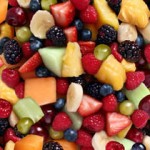A colourful combination of 2-3 seasonal, non-browning fruits of different colours e.g. green grapes + satsuma, kiwi + red grapes, blackberries + raspberries, strawberries + nectarines
Skills Check
Follow a recipe; follow food safety and hygiene rules; tidy away; use weighing scales; cut using bridge/claw technique safely.
Equipment
Knife, chopping board, weighing scales, food containers/pots.
Allergens
None
Ingredients (serves 2):
- 80 g seasonal non-browning fruit
- 80 g seasonal non-browning fruit (different colour)
Method
- Wash the fruit and prepare into bitesize chunks / segments. (Cut grapes in half for children under 5 years to avoid choking hazard).
- Divide the prepared fruit between the plastic food containers. Cover with lids & keep cool until ready to serve.
So thinking about Phunky Fruit Pots ...

Nutritional Information
| - | Energy | 153kJ / 36kcal | 2% |
| Low | Fat | 0.2g | 0% |
| Low | Saturates | 0.05g | 0% |
| Med | Sugars | 5.5g | 6% |
| Low | Salt | 0.01g | 0% |
per 80g serving
% of an adult's reference intake
Typical values per 100g: Energy 191kJ / 45kcal
Notes
A traffic light system is used on nutrition labels to make it easier to see which foods and drinks are lower in calories, fat, sugar and salt. Try and choose more ‘greens’ and ‘ambers’ and fewer ‘reds’, and stick to smaller portions of ‘reds’.
Just because a recipe or a food has a red traffic light doesn’t mean you shouldn’t eat it. Understanding why a food or recipe might have a red light can be helpful. For example oily fish is high in total fat and so any recipe containing oily fish is likely to be ‘red’ for fat. But it is recommended that we eat oily fish at least once a week because the type of fat it contains is beneficial for our health.
% Reference Intakes are also shown. Reference Intakes are guidelines about the approximate amount of particular nutrients and energy required for a healthy diet (based on an average-sized woman doing an average amount of physical activity). Most children will require less than these Reference Intakes. The contribution of one serving of a food or drink to the Reference Intake for each nutrient is expressed as a percentage.



